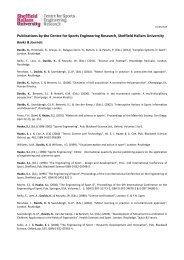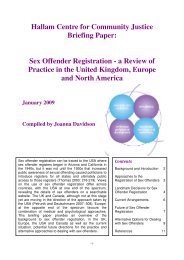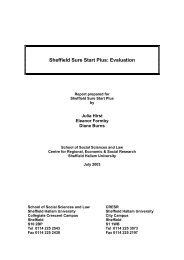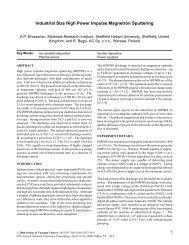The exercise of judicial discretion in rent arrears cases - Sheffield ...
The exercise of judicial discretion in rent arrears cases - Sheffield ...
The exercise of judicial discretion in rent arrears cases - Sheffield ...
You also want an ePaper? Increase the reach of your titles
YUMPU automatically turns print PDFs into web optimized ePapers that Google loves.
For each case <strong>in</strong> the observed sessions, the researcher sought to record the important facts<br />
<strong>in</strong> the case, <strong>in</strong>clud<strong>in</strong>g (where available):<br />
Weekly <strong>rent</strong><br />
Any outcome requested by claimant<br />
Representation <strong>of</strong> defendant – <strong>in</strong> person, legally, <strong>in</strong> writ<strong>in</strong>g<br />
Level <strong>of</strong> <strong>arrears</strong><br />
Any hous<strong>in</strong>g benefit issues<br />
Any previous hear<strong>in</strong>gs<br />
Family make-up <strong>of</strong> defendant<br />
Work history <strong>of</strong> defendant<br />
Outcome <strong>of</strong> case at hear<strong>in</strong>g<br />
In order to confirm any facts established at the hear<strong>in</strong>g, the researchers also checked the<br />
details aga<strong>in</strong>st those <strong>in</strong> the court file. We also sought to record the nature <strong>of</strong> the judges’<br />
<strong>in</strong>teractions with both parties, although it must be acknowledged that the presence <strong>of</strong> a<br />
researcher <strong>in</strong> court may have affected the way that judges dealt with claimants and<br />
defendants.<br />
Given the qualitative focus <strong>of</strong> the research we have used this quantitative database merely<br />
to describe outcomes and difference, without seek<strong>in</strong>g to provide a statistical analysis which<br />
might ascribe statistical significance to diffe<strong>rent</strong> facts about defendants.<br />
We have focused the majority <strong>of</strong> our quantitative analysis on the 540 hear<strong>in</strong>gs which were<br />
the first time that case came to court, <strong>in</strong> order to compare outcomes <strong>of</strong> the same type <strong>of</strong><br />
hear<strong>in</strong>g. 289 <strong>of</strong> these first hear<strong>in</strong>gs (54%), <strong>in</strong>volved tenants <strong>of</strong> local authorities and 245<br />
(46%) hous<strong>in</strong>g association tenants. Of these 303 (56%) were secure tenants and 237 (44%)<br />
were assured tenants. <strong>The</strong> largest number <strong>of</strong> hear<strong>in</strong>gs observed was <strong>in</strong> London, which had<br />
the most frequent and longest hous<strong>in</strong>g possession lists dur<strong>in</strong>g the study period. Table 13<br />
sets out the distribution <strong>of</strong> <strong>cases</strong> between the courts:<br />
Table 13: Distribution <strong>of</strong> first hear<strong>in</strong>g <strong>cases</strong> between courts (n=540)<br />
Court Number <strong>of</strong> Cases % <strong>of</strong> total<br />
London 363 67%<br />
West Country 47 9%<br />
Northern 1 61 11%<br />
Northern 2 69 13%<br />
115
















